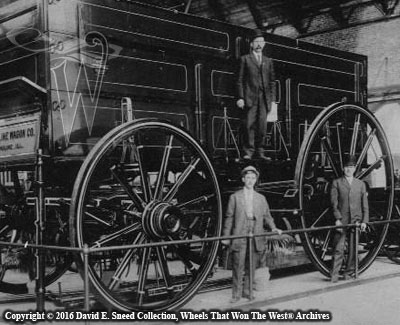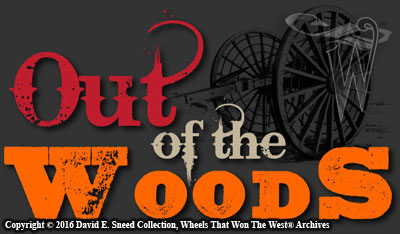The world of advertising has a way of lauding the biggest, baddest, toughest, strongest, fastest, and most action-packed products from all over the globe. From monster trucks to giant earth-moving equipment, countless oversized vehicles are regularly included in those tributes.
With that in mind, in August of 2015, we shared a story about a huge freight wagon built by M.P. Henderson in 1899. At the time, it was billed as the largest wagon in the world. With an overall height of 13.5 feet and rear wheels measuring 8 feet in diameter, this single wagon was designed to be pulled by 18-20 animals. Five years later, at the 1904 World's Fair, the Moline wagon company showcased an even larger wagon. At 42 feet in overall length (versus 33 feet on the Henderson), the massive Moline wagon had rear wheels that towered 9 feet from the ground. Talk about a head-turner!
 |
All that is known to remain of this giant Moline brand wagon are a few photos and promotional pieces created between 1904 and 1906. |
While 9-foot wheels are impressive, even larger logging carts (referred to as Big Wheels or High Wheels) were used to haul timber in numerous areas of the U.S. - especially Michigan and the western Pacific states. These wooden warriors had wheels stretching as much as 10 to 12 feet in height. Today,it's easy to stare in wonder at the survivors; marveling at the challenges in manufacturing such wheels, let alone the unique skills necessary to efficiently operate them.
Recently, I came across a virtually unknown article touting yet another massive set of wheels. This time, the period commentary was focused on a wagon built for the demanding challenges of the Alaskan tundra. Once again, it appears that someone was upping the ante on who was the biggest. The year was 1909 and whether it was truly the largest set of wagon wheels at the time is almost immaterial since it's a safe bet that this rig had few equals. Below is the text from the 107-year-old article...
"Seattle (Wash.) papers tell with pride of a local wheel-making achievement. It is announced that the largest wagon wheels ever made have just been finished in the George W. Hoffman Carriage Works there for W. J. Roe, a drayman and contractor of Nome, Alaska. They are twelve feet high and weigh about 3500 pounds each. They will be used by Roe to haul heavy machinery over the tundra.
The wheels are two feet larger than any others ever built, 10-foot wheels having been constructed for the purpose of hauling logs and big timbers. The Hoffman wheels are of fir, except the iron rim, which is 14 inches wide and five-eighths of an inch thick. The rim is shrunk onto the felloes in two parts."
If you've ever seen the massive Borax freight wagons (20 Mule Team) from Death Valley, you know just how impressively-sized some of these early monstrous wheels can be. For the record, the max widths on most of the Borax wagons is 8 inches. By comparison, you'd have to add another half a foot to equal the running surface (1 foot 2 inches total) of the Hoffman wagon wheels mentioned above. Plus, each wheel weighed the better part of 2 tons!

We've published several articles referring to the Big Wheel logging carts and other massive freighting machines.
While a number of century-plus-old 'Big Wheel' logging carts have survived and can be seen today, the other giants mentioned in this week's blog seem to have disappeared. After several years of promotional appearances at state fairs in the U.S., the big Moline wagon vanished from news accounts. To this day, no one seems to know what happened to the wagon. Likewise, the last mention I was able to find on the La Fortuna freighter built by M.P. Henderson was a write-up discussing an exhibit put on inYuma, Arizona soon after the newly-made wagon was delivered. The freighter was reported to hold a whopping ten tons of freight and was, ultimately, put in service between the railroad in Yuma and the La Fortuna mine.
From associated human interest stories to the individual vehicles and the size of the West, itself, America's wood-wheeled wagons are much more than antiquated curiosities and relics... they are a direct connection to America's DNA, testimonies to the heart and soul of free enterprise and first-hand witnesses to virtually every facet of America's move west. Today, we're on the trail of a number of these historic pieces and the provenance they hold. It's a ride with almost as many ups and downs and unexpected happenings as could be had crossing the mountains and plains in the 1800's. Week by week, we'll share some of these details and continue to encourage you to share your own experiences and travels. It's always good to hear from you. Have a great week!
Please Note: As with each of our blog writings, all imagery and text is copyrighted with All Rights Reserved. The material may not be broadcast, published, rewritten, or redistributed without prior written permission from David E. Sneed, Wheels That Won The West® Archives.